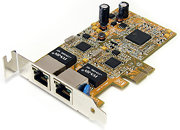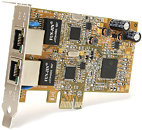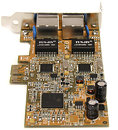Thursday, December 22nd 2011
StarTech.com Announces Low-Profile Dual Port PCIe Gigabit Ethernet Card
StarTech.com, a leading manufacturer of hard-to-find connectivity parts has announced the release of the (SKU: ST1000SPEXD2) Low Profile Dual Port PCIe Gigabit Ethernet Network Card - a PCI Express Network Adapter Card that supports high performance, dual-channel networking and maximum data transfer speeds of 1000 Mbps in each direction (2000 Mbps total) - up to 10 times faster than 10/100 Ethernet.
The network card is ideal for adding two separate Gigabit network ports to any PCI Express-enabled client, server or workstation, which enables the host system to connect to two networks simultaneously. The network card features a low profile design that makes it suitable for small form factor computers (servers, desktops), and includes an optional full profile bracket for installation in full-sized computer systems and larger servers.The Dual Port PCIe Gigabit Ethernet Card (SKU: ST1000SPEXD2) offers the following features:
The network card is ideal for adding two separate Gigabit network ports to any PCI Express-enabled client, server or workstation, which enables the host system to connect to two networks simultaneously. The network card features a low profile design that makes it suitable for small form factor computers (servers, desktops), and includes an optional full profile bracket for installation in full-sized computer systems and larger servers.The Dual Port PCIe Gigabit Ethernet Card (SKU: ST1000SPEXD2) offers the following features:
- Supports features such as Jumbo Frames, VLAN tagging and Wake on LAN (WOL)
- Fully compatible with IEEE 802.3/u/ab standards
- Includes full and low profile installation brackets
- Crossover Detection & Auto-Correction (Auto MDIX)




21 Comments on StarTech.com Announces Low-Profile Dual Port PCIe Gigabit Ethernet Card
Who want some Intel NIC?
[edit]No free ads for random eBay sellers. Though the point that you can get a dual port Intel NIC for $60 is fair.[/edit]
I said PITTY they couldnt support dual link Like some Asus boards. - Some Asus boards have dual Giga network ports and you can plug a cable into each of them and with some asus software have them 'dual linked' so they function as 1 cable but have the throughput of 2 as the software probably dedicates one cable to all outgoing data and the other one to all incoming data - Dont ask me how it works as I dont know since I have never used the software or feature before on ANY of my asus boards, but the feature is still there if you need it.
- not trying to be rude (last thing i want to do is piss off a mod/admin :p) but if you still dont understand what ive written after this - maybe you should take a break from TPU for a bit.
It was just a random guess on my behalf just like when i say that i think the Hadron collider could be powered by pixies, ranbows and unicorns.
Still interesting to know that the feature is indeed a gimmick anyway, I always thought of it of being something pretty cool, but ive never needed it. I have 3-4 systems hooked up in my room through an unmanned gigaswitch that gives me transfer rates anywhere upto 50-80mb/s - but that depends which system im transfering from as i do have some older hardware in some which is potentially bottlenecking the transfer speeds.
It's not a gimmick per se. It's mostly used as backup though, similar to RAID 1. One cable fails, other takes over.
even if the intended market is mainly for OEMs, most motherboards already come with decent gigabit ports so i fail to see what this adds aside from being able do daisy chain computers but that will probably cause a lot of latency issues and interference if your connection has to go through about 5 or 10 computers before reaching an internet hub.
People on a budget are probably pretty satisfied with their built in network card to spend money on a new one unless that one stops working for random reasons
Two smaller chips show Realtek logo.
SOMEONE SUE THEM.